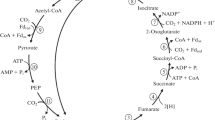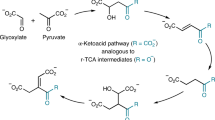Abstract
Kreb's tricarboxylic (TCA) cycle was studied in Halobacterium salinarum cells grown in the presence of glucose or alanine. The cells were incubated with 13C-labeled substrate and the labeling pattern of various carbon positions in glutamate was monitored by 13C-NMR spectroscopy. [2-13C]pyruvate, when used as a substrate, led mainly to signals for C-1 and C-5 glutamate, with some C-3 glutamate. [3-13C]pyruvate as a substrate produced signals, mainly C-2, C-3, and C-4 glutamate, with some C-1 and C-5 glutamate. The multiplicity of the signals and observation of a C-1 signal in this case indicates extensive cycling of the label in the TCA cycle. Isotopomer analysis of glutamate labeling suggested that of the total pyruvate entering the TCA cycle, the flux through pyruvate:ferredoxin oxidoreductase was 90% while that through pyruvate caboxylase was 10%. Only 53% of the total acetyl-CoA was produced from the added labeled pyruvate, the rest being generated endogenously. In the presence of nitrogen, mainly transamination reaction products were formed in the case of both these substrates.
Similar content being viewed by others
Author information
Authors and Affiliations
Additional information
Received: November 26, 1997 / Accepted: May 11, 1998
Rights and permissions
About this article
Cite this article
Ghosh, M., Sonawat, H. Kreb's TCA cycle in Halobacterium salinarum investigated by 13C nuclear magnetic resonance spectroscopy. Extremophiles 2, 427–433 (1998). https://doi.org/10.1007/s007920050088
Issue Date:
DOI: https://doi.org/10.1007/s007920050088




